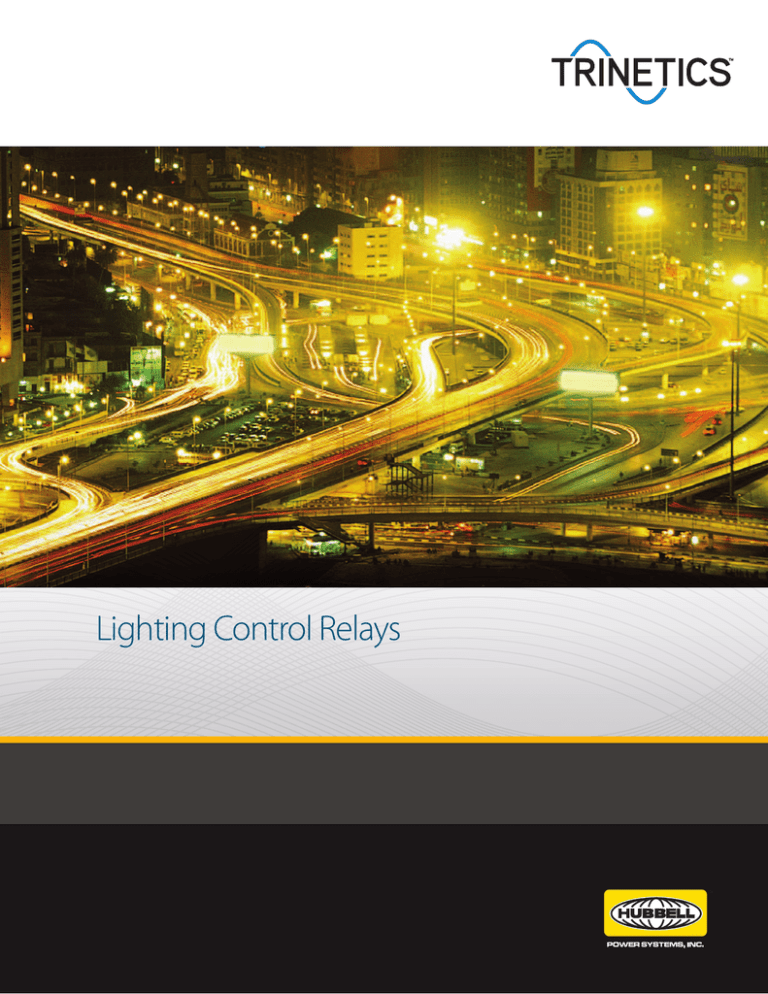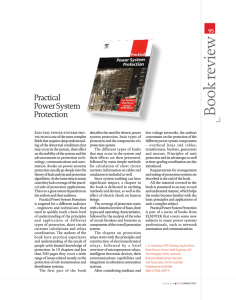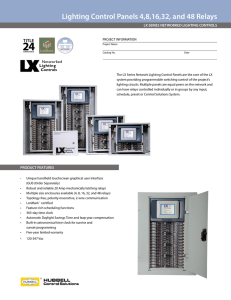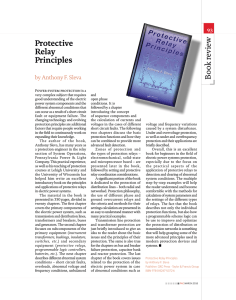Lighting Control Relays
advertisement

Lighting Control Relays Relay Series A lighting system designer generally has a choice of using a multiple relay or individual lamp controls. In some cases, self-controlled luminaries are a good option. However, when the lighting system must extend beyond a confined area or the number of lamps exceeds five or six, a multiple relay should be considered. Multiple relays offer several unique advantages: • Single-point maintenance • Primary circuits are energized only at night • Lightning protection available for the load, line and control circuits • Circuitry can be de-energized for service safely day or night • All lamps come on and go off at the same time • Only one control is required MTR The MTR Series is designed for users who prefer mercury tube contactors that are hermetically sealed, have no contactor wear points, no-spark operation and only one moving part. The single moving part is a ceramic plunger that causes mercury to flow together or separate to electrically close and open the load circuit. The ruggedness and reliability of this simple design has been proven in thousands of field applications. The MTR Series is available in the following standard versions: • One or two pole • Normally open or normally closed • 30, 60 or 100 amp RLY Series • MR Series • MTR Series • RLY Series The RLY Series was developed for lighting system designers in need of an inexpensive control relay that outperforms throw-away type units that are sealed or difficult to repair. The reputation of the Trinetics line proves durability and maintainability are essential to cost-efficient lighting relays. The RLY Series offers superior service life, durability and maintainability at a competitive purchase price. The RLY Series is offered in the following standard versions: • Special Series • One or two pole • Normally open or normally closed • 30 amp Trinetics offers an extensive line of multiple relay lighting controls. Commonly referred to as RCOC (Remote Control of Outdoor Circuits) relays, the company manufactures the following product lines: MR Series The MR Series is the foundation of the Trinetics product line of multiple relay lighting controls. MR relays feature a time-proven electromagnetic design that provides high compression, low audible noise and minimum eddy current heating. For customers in need of heavy duty construction and long-term performance, the MR Series is built for years of trouble-free service in the most challenging environments. This open air contact style relay is offered in the following configurations: Special Series • One or two pole This catalog details 20 of the most popular relays; however, Trinetics also manufactures a variety of speciallydesigned lighting controls. Available in electromagnetic or mercury tube configurations, these special order relays are variations of time proven designs. If you have a unique load, wiring or case requirement, contact Trinetics to find a relay that meets your specific lighting control need. Custom relays are available in the following configurations: • Normally open or normally closed • One or two pole • 30, 60 or 100 amp • Normally open or normally closed • 30, 60 or 100 amp Lighting Control Relays 1 Relay Features Cases and Covers Grounding Much of the popularity of the Trinetics RCOC line is due to the rugged design and durability of the enclosures. Controls are housed in aluminum, bakelite or Lexan® cases and covers. All units rated for 480 volt service and most 100 amp controls are supplied with a case grounding terminal for added safety. Any aluminum case can be so equipped if specified. Most MR relays, as well as the 60 and 100 amp MTR relays, are furnished with rugged aluminum enclosures. These cases are built with a hinged cover and an integral padlock hasp. Certain 30 amp MR relays are the exception; these controls are housed in a heavy-duty bakelite case with an aluminum cover. Nameplate Data The 30 amp MTR and RLY relays come standard with UV-stable Lexan cases. These enclosures have a detachable cover retained by an integral safety chain that ensures ample working room and easy service access. Aluminum enclosures are also available as an option for these 30 amp relays. All Trinetics relays include plated brass, stainless steel or aluminum fasteners and mounting hardware. There are no unused holes or knockout type perforations. All entrance holes are drilled at the factory, sized and located directly in line with internal connection terminals. The relays will retain their original appearance and integrity for many years. Weather Seals Trinetics relays have enclosures with one piece, die-cut or hand-cut rubber gaskets. The gaskets retain their elasticity and compressibility in all weather conditions for the life of the unit and will not stick or break when servicing the control. Close tolerance control of the case, cover and hinge geometry ensures uniform gasket compression. Photocell receptacles are sealed with solid neoprene gaskets. All materials are highly resistant to ozone aging. Grommeting Neoprene grommets with flexible inside diameter are furnished where primary and control cable sizes would normally be up to 3/8 inch diameter. Cable grips are installed for larger wire up to 9/16 inch diameter. The customer may specify the size and location of drilled holes for conduit fittings. Security All aluminum enclosures are furnished with provisions for padlocking the door to prevent inquisitive or destructive entry. 2 Lighting Control Relays On cast aluminum enclosures, identification and rating information is permanently etched and metal stamped on a heavy duty nameplate which is secured to the door with drive screws. The data remains legible for the life of the unit. Bakelite enclosures also include an aluminum nameplate, which is secured to the cover of the relay. Lexan enclosures are marked with a laminated label. Mechanisms The basis for Trinetics’ superiority in the lighting controls industry is the construction of the relay mechanism. Current-carrying circuit elements are always conservatively rated. Mechanical assemblies employ threaded fasteners, not rivets and clips. Molded and extruded parts are avoided in favor of machined components. Each mechanism is carefully assembled and tested by qualified personnel using time-tested methods and traditional workmanship. Clearances Spacing of components and terminal locations within the enclosure are governed by two basic considerations, dielectric properties and access to field connections. All components are spaced to provide high dielectric strength even in the most adverse environment, high humidity and salt air. Field connections are located directly in line with their entrance ports. There is adequate room for safe and convenient attachment of incoming wires. Panels Components are mounted on high quality phenolic panels chosen for their superior electrical properties and strength. The boards are 5/16” thick and have very high dielectric ratings, extremely low water absorption coefficients and heat resistance. The material lends itself to close tolerance machining and is dimensionally stable. Magnets Mercury Tube Contactors The electromagnets in Trinetics relays are built by us to our own design. They are exactly matched to the requirements of our lighting control relay. Laminations are of high quality electrical steel. Assembly methods assure high compression and fit for low audible noise and minimum eddy current heating. The mercury tube contactors are of hermetically sealed steel tube construction and offer the inherent advantages and benefits of silent switching, long life, high inrush capabilities, contact arc quenching and the structural advantages that are provided in the steel tube construction. These contactors operate in a wide range of temperatures, under low or high pressures, in dust or vapor filled environments. The magnets are zinc and die-chromate plated for corrosion resistance. A phosphor bronze breaker strip is used on the clapper type armature to reduce the effects of residual magnetism during dropout. This increases the speed of contact separation, thereby reducing arc length and contact erosion. Coils All Trinetics multiple relay coils are wound on a nylon bobbin and sealed in a pressure molded, high crystalline nylon resin outer casing. They have a Class B (130°C) insulation rating, but in normal service will not exceed 55°C. Each coil has an operating voltage range of ±20% of nominal and is tested by the factory at both extremes. The moisture barrier has been proven by underwater functional testing. Power rating are given in the chart on page 5. Contacts Contact material is silver cadmium oxide, a sintered alloy chosen for its ability to withstand high inrush currents, antiwelding properties, low contact resistance and durability. The contacts are induction brazed onto electrolytic copper studs. The surfaces are slightly crowned for perfect mating at their centers. In every relay, contact gaps and pressures are adjusted at final test to insure proper operation and long life. Relays can be supplied with normally open or normally closed contacts. Action The clapper type magnet imparts a sweeping motion to the moving contacts which generates our unique “wiping” action. The contacts meet at their outer edges, wipe themselves clean and seat firmly at their centers. This action locates the make/break arc erosion at the perimeter or nonconducting surface of the contacts. In designs having linear or axial motion, arc erosion is aggravated by contact “bounce.” This phenomenon is all but eliminated by our design. Periodic maintenance is not required. Fusing Fuses should be included in any circuit to which the public is exposed. They afford protection against shorts in the line and in the ballast. Trinetics relays can be ordered without over-current load circuit protection. All others are shipped with fuses or breakers installed. Fuses supplied with Trinetics relays are the dual element type for low heat rise and 200,000 amp interrupting capacity. The spring-loaded fuse clips are silver plated for long term corrosion resistance. The recommended loads shown in the chart on page 5 reflect the NEMA standard limitation of loading fuses to 80% of their rated current. Control circuit fusing can be supplied if specified separately. When circuit breaker protection is specified, Trinetics uses the E-frame, magnetic trip type with 5000 amp interrupter capacity. Relays equipped with breakers can be loaded to 100% of the breaker rating. Control Circuit All Trinetics relays are magnetically actuated and held. The control circuit can be energized by a photocell, time clock or manual switch located either within the relay or in a remote location. Most relays are equipped with control circuit lightning protection as standard equipment. Fuse protection is also available is specified. Terminals for connection of remote control wiring will be provided when external control is specified. Photocell Receptacles Receptacles furnished with our relays are the twist-lock type and conform to EEI SPEC TDJ 146 (NEMA SM-16). They are attached with corrosion resistant hardware and weather-sealed with solid neoprene gaskets. Simple provisions for northward orientation are standard. Lighting Control Relays 3 Relay Features (cont.) Lightning Protection Terminals Lightning arresters should be included in areas where frequent electrical storms occur. Most Trinetics relays are equipped with control circuit arresters and can be ordered with optional line and/or load circuit protection. The control terminals are tin-plated copper and will accept wire sizes from No. 14 to No. 6 AWG. The line/load terminal is a three piece unit. The collar is aluminum. The tang is electrolytic copper and the screw is brass, both tin plated. This construction will accept either copper or aluminum cable is sizes No. 6 through 1/0 AWG. The control circuit arresters are the dual expulsion gap type. Each assembly includes two gaps in series from the terminal post to a common ring which provide an alternate path for lightning surges to bypass the coil. The fibre rings are designed to extinguish the surge arc without damage to the assembly or loss of protection. The arresters are designed to arc at one half the impulse level of the control coil. The load circuit arresters are the valve type designed for use on secondary distribution circuits up to 650 volts. Any surge above that level will be instantly shunted to neutral protecting the equipment on the load circuit from damaging voltage. When the surge passes, and the arrester has interrupted the follow current, it then returns to a non-conducting mode. Hand-Off-Auto Switch This is an optional three position, rocker switch installed in the control circuit. In normal service, the switch is in the Auto position. For daytime lamp servicing, moving the switch to the Hand position energizes the control coil turning on the load circuit. If lamp placement is required, moving the switch to the Off position disconnects the control circuit, keeping the load secured for maintenance. Repair work can be quickly checked and the system returned to automatic control. Transformers If line voltage is 480 volts, a 480 to 120 volt transformer should be incorporated to allow the use of 120 volt control. Separate control circuit wiring is not required. The transformer is an integral part of the Trinetics relay. Our transformers are specially designed for a maximum heat rise of 35°C to maintain low internal case temperatures. The units are deliberately oversized to accommodate our minimum coil pull-in voltage requirements. All transformers are custom wound to avoid over voltage at normal power levels. Standard reduction is 480 to 120 volts. Power Distribution In addition to multiple relay lighting controls, Trinetics offers an extensive line of oil and vacuum switchgear. These single-phase, medium voltage products are designed to switch capacitor banks, control lighting circuits and sectionalize power. The VS Series vacuum switch is an exact form, fit and function replacement for existing switches in the field. The product combines the extended operating life and maintenance-free benefits of a vacuum interrupter with the lubrication and insulation advantages of oil. The VS features a manual lever for emergency hook stick operation and is available in 13, 15 and 20 kV models. A proven performer and cost-effective alternative to the VS is the CSD Series oil switch. The CSD is equipped with an electromechanical contact assembly insulated in a transformer oil dielectric. This industry-tested product features automatic and manual operation and is available is 15 and 20 kV versions. The CSD and VS are both designed in conformance with ANSI Standard C37.66. The SPR oil switches are available for remote control of primary circuits. They have an insulation rating of 15 kV and are designed for use on circuits having a maximum line-to-line voltage of 7.5 kV. These primary oil switches are offered in single-pole configuration. Product literature highlighting the specifications of each of these oil and vacuum switch products is available upon request. For more information on the complete line of Trinetics switches and related accessories, contact your local sales representative or the factory. Warranty: The seller warrants that its products shall be free from defects in workmanship and material for a period of one year from date of shipment and that its responsibility is limited to repair or replacement, at its sole discretion, of the defective part(s). The seller shall not be liable for consequential damages or related costs. The foregoing warranty is exclusive and in lieu of all other warranties of quality whether written, oral or implied, including any warranty of merchantability or fitness for purpose. ® Lexan is a registered trademark of the General Electric Company. 4 Lighting Control Relays Load Ratings Loading Chart Ballast Relay Load Voltage Rating Number of Luminaries per Relay Pole 100W175W250W400W700W1000W 120 30 21 12 9 6 3 2 120 60 43 25 18 12 6 5 120 100 72 42 30 20 10 8 208 30 38 21 16 10 6 4 208 60 76 43 32 20 10 8 208 100 127 72 53 33 16 14 240 30 43 25 18 12 7 5 240 60 86 50 36 24 14 10 240 100 144 84 60 40 23 16 277 30 51 28 21 13 8 5 277 60 102 57 43 26 16 11 277 100 170 96 72 44 27 19 480 30 88 50 35 22 13 9 480 60 172 100 72 48 26 20 480 100 288 160 115 72 44 32 This chart provides the suggested maximum number of luminaries per relay pole based on the use of regulated ballasts and the NEMA standard limitation of loading fuses to 80% if their rated current. Capacities will be slightly less when nonregulated ballasts are used. Coil Ratings Relay Type Relay Rating Amps Coil Current 120V 50/60 Hz InrushContinuous Coil Current 240V 50/60 Hz InrushContinuous MR 30 .330 .060 .150 .035 MR 60 .600 .132 .550 .275 MR 100 .600 .132 .550 .275 MTR 30 .080 .053 .042 .028 MTR 60 .104 .069 .051 .034 MTR 100 .293 .195 .155 .103 Nonstandard coils are available for other control voltages and frequencies. For specific information, contact your Trinetics sales representative or the factory. Lighting Control Relays 5 Reference Information Product Data Poles Amps Volts Photocell Case Receptacle Type Spec Page 1 30 120 Bakelite Yes MR-XG 6356 7 1 30 120/240 Bakelite No MR-TD 6245 7 1 30 120/240 Bakelite No MR-XD 6283 8 1 30 120/240 Lexan Yes RLY-XG 6785 8 2 30 120/240 Bakelite No MR-WC 6407 9 2 30 120/240 Bakelite Yes MR-WI 6400 9 2 30 120/240 Die-cast Aluminum Yes MR-WO 6585 10 2 30 120/240 Lexan Yes MTR-WG 6793 10 1 60 120/240 Die-cast Aluminum No MR-KD 6559 11 1 60 120/240 Die-cast Aluminum Yes MR-KG 6551 11 1 60 480 Sand-cast Aluminum Yes MR-HG 6398 12 1 60 480 Sand-cast Aluminum Yes MR-HHF 6651 12 2 60 120/240 Die-cast Aluminum No MR-UD 6342 13 2 60 120/240 Die-cast Aluminum Yes MR-UG 6338 13 2 60 240/480 Die-cast Aluminum Yes MR-ZH 6406 14 2 60 480 Die-cast Aluminum No MR-ZD 6308 14 1 100 120 Sand-cast Aluminum Yes MR-FG 6379 15 1 100 480 Sand-cast Aluminum Yes MR-ESA 6682 15 2 100 120/240 Sand-cast Aluminum Yes MR-YG 6314 16 2 100 120/240 Sand-cast Aluminum Yes MR-YO 6442 16 The 20 relays listed in the product data chart above satisfy most applications. When ordering, reference our type and spec numbers. Should special or unusual conditions arise, specifications can be defined based on the following parameters. • Specify primary voltage and current Trinetics relays handle 30 to 100 amp and 120 to 480 volt requirements. • Specify control voltage and frequency Trinetics relays offer 120 or 240 volt control coils for 50 or 60 Hz systems and transform from 480 to 120 volts, when required. • Specify provisions for photocell Trinetics relays can be equipped with a photocell receptacle or wired for remote control. • Specify protective equipment desired Trinetics control coils can be protected by lightning arresters and primary circuits by breakers or dual element load fuses. • Specify case and mounting data Trinetics relays are available in a variety of case and hanger configurations. Describe the style, size, quantity and location of connection parts required. 6 Lighting Control Relays 1-Pole, 30 Amp Relays MR-XG Specification 6356 MR-TD Specification 6245 Lighting Control Relays 7 1-Pole, 30 Amp Relays MR-XD Specification 6283 8 Lighting Control Relays RLY-XG Specification 6785 2-Pole, 30 Amp Relays MR-WC Specification 6407 MR-WI Specification 6400 Lighting Control Relays 9 2-Pole, 30 Amp Relays MR-WO Specification 6585 1 0 Lighting Control Relays MTR-WG Specification 6793 1-Pole, 60 Amp Relays MR-KD Specification 6559 MR-KG Specification 6551 Lighting Control Relays 11 1-Pole, 60 Amp Relays MR-HG Specification 6398 12 Lighting Control Relays MR-HHF Specification 6651 2-Pole, 60 Amp Relays MR-UD Specification 6342 MR-UG Specification 6338 Lighting Control Relays 1 3 2-Pole, 60 Amp Relays MR-ZH Specification 6406 14 Lighting Control Relays MR-ZD Specification 6308 1-Pole, 100 Amp Relays MR-FG Specification 6379 MR-ESA Specification 6682 Lighting Control Relays 15 1-Pole, 100 Amp Relays MR-YG Specification 6314 1 6 Lighting Control Relays MR-YO Specification 6442 ©2013 Hubbell Power Systems. All rights reserved. Hubbell, the Hubbell logo are registered trademarks or trademarks of Hubbell Power Systems. All other trademarks are the property of their respective owners. SS_03_019_E_0213




